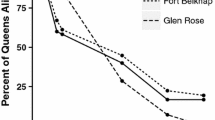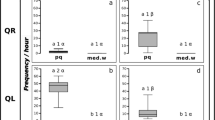Abstract
The fate of queen foundress associations in ants varies across taxa: in some, lethal fighting results in survival of a single queen, while in others, queens coexist long term. One hypothesis for this difference is that selection favors fighting when group sizes are small and tolerance when groups are large. In an experiment with the ant Messor pergandei, we formed small, medium, and large groups with newly mated queens from field populations that have different mean group sizes and differ in whether multiple queens occur in older established colonies. We found that whether queens are eliminated by fighting depends upon region of origin and not group size: regardless of co-foundress number, queens from sites with single-queen adult field colonies displayed agonistic behaviors and their colonies reduced to a single queen, while queens from sites with multiple-queen colonies did not fight and co-foundresses coexisted long term. Worker aggression towards and elimination of queens were also correlated with region of origin. Where fighting occurred, queens were as likely to be killed by workers as by other queens. An aggressive display was the most common form of agonistic interaction among queens, while fighting was relatively rare. We hypothesize that queen displays evolved in response to worker attacks because they increase the probability that workers will eliminate competitor queens. Our results suggest that the evolutionary interests of workers, as well as queens, could be important in determining the evolution and maintenance of queen elimination in foundress associations.




Similar content being viewed by others
References
Adams ES, Balas MT (1999) Worker discrimination among queens in newly founded colonies of the fire ant Solenopsis invicta. Behav Ecol Sociobiol 45:330–338
Altmann J (1974) Observational study of behaviour: sampling methods. Behaviour 49:227–267
Aron S, Steinhauer N, Fournier D (2009) Influence of queen phenotype, investment and maternity apportionment on the outcome of fights in cooperative foundations of the ant Lasius niger. Anim Behav 77:1067–1074
Balas MT (2005) Conditions favoring queen execution in young social insect colonies. Insect Soc 52:77–83
Balas MT, Adams ES (1996) The dissolution of cooperative groups: mechanisms of queen mortality in incipient fire ant colonies. Behav Ecol Sociobiol 38:391–399
Bartz SH, Hölldobler B (1982) Colony founding in Myrmecocystus mimicus Wheeler (Hymenoptera: Formicidae) and the evolution of foundress associations. Behav Ecol Sociobiol 10:137–147
Bernasconi G, Keller L (1998) Phenotype and individual investment in cooperative foundress associations of the fire ant, Solenopsis invicta. Behav Ecol 9:478–485
Bernasconi G, Strassmann JE (1999) Cooperation among unrelated individuals: the ant foundress case. Trends Ecol Evol 14:477–482
Cahan S, Helms KR, Rissing SW (1998) An abrupt transition in colony founding behaviour in the ant Messor pergandei. Anim Behav 55:1583–1594
Cook JM, Compton SG, Herre EA, West SA (1997) Alternative mating tactics and extreme male dimorphism in fig wasps. Proc R Soc Lond B 264:747–754
Creighton WS (1950) The ants of North America. Bull Museum Comp Zool 104:1–685
Crespi BJ (1988) Risks and benefits of lethal male fighting in the colonial, polygynous thrips Hoplothrips karnyi (Insecta: Thysanoptera). Behav Ecol Sociobiol 22:293–301
Cronin, AL, Monnin, T (2009) Bourgeois queens and high stake games in the ant Aphaenogaster senilis. Frontiers in Zoology 6:24 http://www.frontiersinzoology.com/content/6/1/24
Endler A, Liebig J, Hölldobler B (2006) Queen fertility, egg marking and colony size in the ant Camponotus floridanus. Behav Ecol Sociobiol 59:490–499
Enquist M, Leimar O (1990) The evolution of fatal fighting. Anim Behav 39:1–9
Emlen DJ (2008) The evolution of animal weapons. Ann Rev Ecol System 39:387–413
Field J, Paxton RJ, Soro A, Bridge C (2010) Cryptic plasticity underlies a major evolutionary transition. Curr Biol 20:2028–2031
Forsyth A (1980) Worker control of queen density in Hymenopteran societies. Am Nat 116:895–898
Fucini S, Di Bona V, Mola E, Piccaluga C, Lorenzi MC (2009) Social wasps without workers: geographic variation in caste expression in the paper wasp Polistes biglumis. Insect Soc 56:347–358
Gill RJ, Arce A, Keller L, Hammond RL (2009) Polymorphic social organization in an ant. Proc R Soc B Lond, Ser B 276:4423–4431
Gilley DC (2001) The behavior of honey bees (Apis mellifera ligustica) during queen duels. Ethology 107:601–622
Guisan A, Edwards TC Jr, Hastie T (2002) Generalized linear and generalized additive models in studies of species distributions: setting the scene. Ecol Model 157:89–100
Heinze J, Weber M (2011) Lethal sibling rivalry for nest inheritance among virgin ant queens. J Ethol 29:197–201
Helms KR, Helms Cahan S (2012) Large scale regional variation in cooperation and conflict among queens of the desert ant Messor pergandei. Anim Behav 84:499–507
Helms Cahan S (2001) Ecological variation across a behavioral transition zone in the ant Messor pergandei. Oecologia 129:629–635
Helms Cahan S, Helms KR (2012) Relatedness does not explain geographic variation in queen cooperation in the seed-harvester ant Messor pergandei. Insect Soc 59:579–585
Hölldobler B, Carlin NF (1985) Colony founding, queen dominance and oligogyny in the Australian meat ant Iridomyrmex purpureus. Behav Ecol Sociobiol 18:45–58
Hölldobler B, Wilson EO (1990) The ants. Cambridge, Belknap
Holman L, Dreier S, d'Ettorre P (2010) Selfish strategies and honest signaling: reproductive conflicts in ant queen associations. Proc Roy Soc Lond B 277:2007–2015
Huntingford FA, Turner AK, Downie LM (1987) Animal conflict. Chapman & Hall, Boca Raton
Innocent TM, West SA, Sanderson JL, Hyrkkanen N, Reece SE (2011) Lethal combat over limited resources: testing the importance of competitors and kin. Behav Ecol 22:923–931
Jeanson R, Fewell JH (2008) Influence of the social context on division of labor in ant foundress associations. Behav Ecol 19:567–574
Johnson RA (2000) Reproductive biology of the seed-harvester ants Messor julianus (Pergande) and Messor pergandei (Mayr) (Hymenoptera: Formicidae) in Baja California, Mexico. J Hymenopt Res 9:377–384
Keller L, Passera L (1989) Size and fat content of gynes in relation to the mode of colony founding in ants (Hymenoptera; Formicidae). Oecologia (Berl) 80:236–240
Keller L, Ross KG (1998) Selfish genes: a green beard in the red fire ant. Nature 394:573–575
King JA (1973) The ecology of aggressive behavior. Ann Rev Ecol Syst 4:117–138
Krieger MJB, Ross KG (2005) Molecular evolutionary analyses of the odorant-binding protein gene Gp-9 in fire ants and other Solenopsis species. Mol Biol Evol 22:2090–2103
Lawson LP, Vander Meer RK, Shoemaker D (2012) Male reproductive fitness and queen polyandry are linked to variation in the supergene Gp-9 in the fire ant Solenopsis invicta. Proc R Soc Lond B 279:3217–3222
Maynard Smith J, Price GR (1973) Logic of animal conflict. Nature 246:15–18
Pamilo P, Rosengren R (1984) Evolution of nesting strategies of ants: genetic evidence from different population types of Formica ants. Biol J Linn Soc 21:331–348
Parker GA (1974) Assessment strategy and the evolution of fighting behavior. J Theor Biol 47:223–243
Pfennig DW (1995) Absence of joint nesting advantage in desert seed-harvester ants: evidence from a field experiment. Anim Behav 49:567–575
Reeve HK, Ratnieks FLW (1993) Queen-queen conflicts in polygynous societies: Mutual tolerance and reproductive skew. In: Keller L (ed) Queen number and sociality in insects. Oxford University Press, New York, pp 45–85
Rissing SW, Pollock GB (1987) Queen aggression, pleometrotic advantage and brood raiding in the ant Veromessor pergandei. Anim Behav 35:975–981
Rissing SW, Johnson RA, Martin JW (2000) Colony founding behavior of some desert ants: geographic variation in metrosis. Psyche 103:95–101
Ryti RT (1988) Geographic variation in cooperative colony foundation in Veromessor pergandei (Hymenoptera: Formicidae). Pan-Pac Entomol 64:255–257
Schlick-Steiner BC, Steiner FM, Sanetra M, Seifert B, Christian E, Stauffer C (2007) Lineage specific evolution of an alternative social strategy in Tetramorium ants (Hymenoptera: Formicidae). Biol J Linn Soc 91:247–255
Sokal RR, Rohlf FJ (1995) Biometry. Freeman, New York
Sommer K, Hölldobler B (1995) Colony founding by queen association and determinants of reduction in queen number in the ant Lasius niger. Anim Behav 50:287–294
Soro A, Field J, Bridge C, Cardinal SC, Paxton RJ (2010) Genetic differentiation across social transition in a socially polymorphic sweat bee, Halictus rubicundus. Molec Ecol 19:3351–3363
Stuart RJ, Francoeur A, Loiselle R (1987) Lethal fighting among dimorphic males of the ant, Cardiocondyla wroughtonii. Naturwissenschaften 74:548–549
Tschinkel WR, Howard DF (1983) Colony founding by pleometrosis in the fire ant, Solenopsis invicta. Behav Ecol Sociobiol 12:103–113
Waloff N (1957) The effect of the number of queens of the ant Lasius flavus (Fab.) (Hym., Formicidae) on their survival and on the rate of development of the first brood. Insect Soc 4:391–408
Went FW, Wheeler J, Wheeler GC (1972) Feeding and digestion in some ants (Veromessor and Manica). BioScience 22:82–89
Wrangham RW (1999) Evolution of coalitionary killing. Yrbk Phys Anthropol 42:1–30
Acknowledgments
We thank Heather Axen for help in the laboratory. For permission to collect queens, we thank the National Park Service (Death Valley National Park) and Phil Smith of the Arizona Game and Fish Department. This research was supported by a grant from the US National Science Foundation, DEB 0742922.
Author information
Authors and Affiliations
Corresponding author
Additional information
Communicated by J. Heinze
Electronic supplementary material
Below is the link to the electronic supplementary material.
Online Resource 1
(DOCX 30 kb)
Appendix 1
Appendix 1
Rights and permissions
About this article
Cite this article
Helms, K.R., Newman, N.J. & Helms Cahan, S. Regional variation in queen and worker aggression in incipient colonies of the desert ant Messor pergandei . Behav Ecol Sociobiol 67, 1563–1573 (2013). https://doi.org/10.1007/s00265-013-1568-8
Received:
Revised:
Accepted:
Published:
Issue Date:
DOI: https://doi.org/10.1007/s00265-013-1568-8




